Digital Poster
Fat & Thermometry
Joint Annual Meeting ISMRM-ESMRMB & ISMRT 31st Annual Meeting • 07-12 May 2022 • London, UK

| Computer # | ||||
|---|---|---|---|---|
| 2165 | 67 | MAGORINO: Magnitude-only fat fraction and R2* estimation with Rician noise modelling
Timothy JP Bray1,2, Alan Bainbridge3, Margaret A Hall-Craggs1,2, and Hui Zhang4
1Centre for Medical Imaging, University College London, London, United Kingdom, 2Department of Imaging, University College London Hospital, London, United Kingdom, 3Medical Physics, University College London Hospital, London, United Kingdom, 4Centre for Medical Image Computing, University College London, London, United Kingdom
Magnitude signal-based fitting of chemical shift-encoded data enables proton density fat fraction (PDFF) and R2* estimation where complex signal-based fitting fails or when phase data are inaccessible/unreliable, such as in multicentre studies. However, traditional magnitude-based fitting suffers from Rician noise-related bias and fat-water swaps, limiting utility. Here, we propose MAGORINO, an algorithm combining Magnitude-Only PDFF and R2* estimation with Rician Noise modelling, to address these limitations. We demonstrate that MAGORINO outperforms traditional Gaussian noise-based magnitude-only estimation through (i) reduced noise-related bias and (ii) reduced fat-water swaps. This may be valuable in multicentre studies or when phase data are otherwise inaccessible/unreliable.
|
||
2166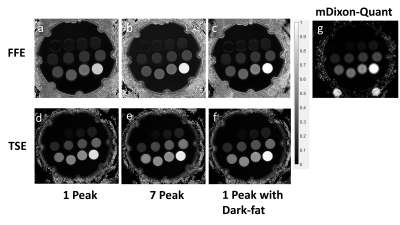 |
68 | Improving the Accuracy of Fat Fraction Values from a 2-Point Dixon Acquisition
Sheng-Qing Lin1, Sebastian Fonseca1, Durga Udayakumar1,2, and Ananth J. Madhuranthakam1,2
1Radiology, UT Southwestern Medical Center, Dallas, TX, United States, 2Advanced Imaging Research Center, UT Southwestern Medical Center, Dallas, TX, United States
Fat fraction (FF) mapping using whole-body MRI is clinically valuable for the assessment of treatment response in diseases such as multiple myeloma. MRI FF maps can be accurately measured using multi-point acquisitions such as mDixon-Quant, however, they are not feasible for whole-body acquisitions. We have previously developed a “dark-fat” masking algorithm that can account for residual fat signal in water-only images from 2-point Dixon fat/water separation, that are readily feasible with whole-body MRI. In this study, we demonstrate the utility of this algorithm across a range of proton-density FF using a multi-compartment commercial FF phantom.
|
||
2167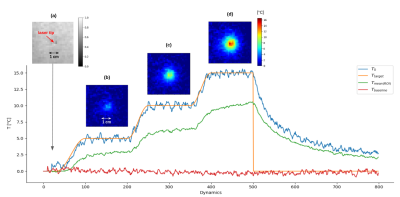 |
69 | Real-time automatic temperature regulation during MRI-guided Laser Interstitial Thermal Therapy (MR-LITT)
Manon Desclides1,2,3, Valéry Ozenne1,3,4,5, Pierre Bour2, Guillaume Machinet6, Christophe Pierre6, Stéphane Chemouny2, and Bruno Quesson3,4,5
1UMR5536 CRMSB, Université de Bordeaux, Bordeaux, France, 2Certis Therapeutics, Pessac, France, 3IHU Liryc, Electrophysiology and Heart Modeling Institute, Hopital Xavier Arnozan, Pessac, France, 4Centre de Recherche Cardio-Thoracique de Bordeaux, U1045, University of Bordeaux, Bordeaux, France, 5INSERM, Centre de Recherche Cardio-Thoracique de Bordeaux, U1045, Bordeaux, France, 6ALPhANOV, Talence, France
We present here a method to automatically regulate heat deposition during Laser Interstitial Thermal Therapy to precisely control temperature evolution during the procedure. The method relies on real-time rapid volumetric thermometry using the Proton Resonance Frequency Shift technique and a regulation algorithm that adjusts every second the emitted power by the laser to force temperature to follow a predefined temperature-time profile.
|
||
2168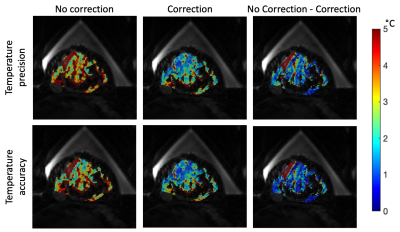 |
70 | Validation of a 3D MR temperature imaging sequence for use during breast magnetic resonance guided focused ultrasound treatments
Samuel Ian Adams1, Sara Johnson2, Henrik Odéen2, Dennis Parker2, and Allison Payne2
1Biomedical Engineering, University of Utah, Salt Lake City, UT, United States, 2Radiology and Imaging Sciences, University of Utah, Salt Lake City, UT, United States
This work presents a 3D MR temperature imaging (MRTI) sequence for breast MRgFUS. A 3D gradient echo with segmented echo planar imaging readout sequence with time-varying drift correction was used in female volunteers and tissue-mimicking phantoms. Temperature changes due to FUS heating in phantoms were measured with fiberoptic probes and compared to MRTI. Non-heating volunteer data was also acquired. Temperature in the phantom studies was accurate compared to FO probes with an RMSE of 1.0°C. Mean precision and accuracy of 1.05 and 1.29°C were measured in healthy volunteers. This sequence provides accurate and precise 3D temperature measurements for breast MRgFUS.
|
||
2169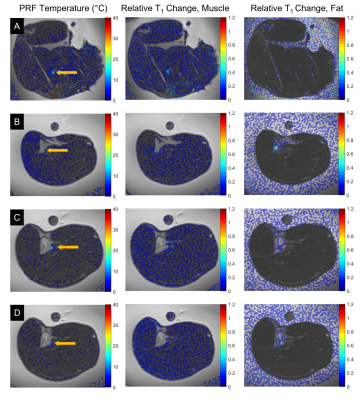 |
71 | In vivo simultaneous proton resonance frequency shift thermometry and single reference variable flip angle T1 measurement
Nicholas Richards1, Henrik Odeen1, Sara Johnson1, Dennis Parker1, and Allison Payne1
1University of Utah, Salt Lake City, UT, United States
Simultaneous proton resonance frequency shift thermometry and T1 measurements were obtained in an in vivo rabbit model using the single reference variable flip angle method. Focused ultrasound was used to heat tissue volumes of muscle and volumes at the fat/muscle interface. Temporal resolution for PRF shift temperatures and T1 changes was 1.71 s. Peak heated muscle voxels showed an increase in T1 of 1.6%/°C. T1 increases were observed in fat at or near the ultrasound focus.
|
||
2170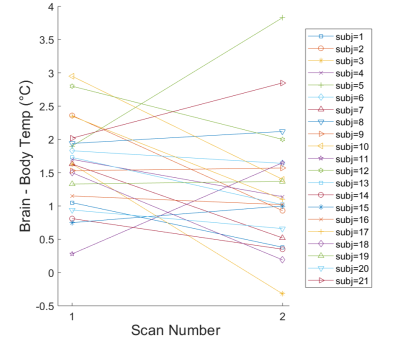 |
72 | Evaluation of Repeated MR Chemical Shift Brain Thermometry in Healthy Humans Video Permission Withheld
Kelly J. Wang1,2, Dongsuk Sung2,3, Benjamin B. Risk4, Jason W. Allen2,3, and Candace C. Fleischer2,3
1Department of Neuroscience, Georgia Institute of Technology, Atlanta, GA, United States, 2Department of Radiology and Imaging Sciences, Emory University School of Medicine, Atlanta, GA, United States, 3Department of Biomedical Engineering, Georgia Institute of Technology, Emory University, Atlanta, GA, United States, 4Department of Biostatistics and Bioinformatics, Emory University, Atlanta, GA, United States
Magnetic resonance (MR) chemical shift thermometry (CST) is the only method that can approximate absolute rather than relative temperature. Our goal was to evaluate repeated body and brain MR CST measurements and the brain-body temperature gradient in healthy human volunteers over a short time period. While brain, body, or the difference between brain and body temperatures were not significantly different, variations in brain temperature between measurements were observed suggesting fluctuations over short time periods. Further investigation into the time scale of brain temperature fluctuations, particularly under controlled conditions to account for physiological changes and neural activity, are warranted.
|
||
2171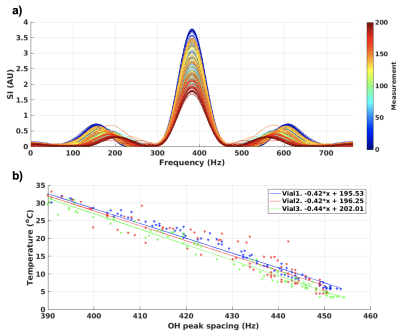 |
73 | High spatial and temporal resolution absolute temperature imaging of Ethylene Glycol
Henrik Odéen1, Lorne Hofstetter1, Seong-Eun Kim1, and Dennis L Parker1
1Radiology and Imaging Sciences, University of Utah, Salt Lake City, UT, United States
Multi-echo MRI was used to image and detect peak spacing between OH groups in ethylene glycol. The OH peak spacing was shown to change linearly with temperature, and the fit from one experiment could be used to accurately reconstruct absolute temperatures from another experiment. This approach can provide high spatial and temporal resolution absolute temperature measurements for ex vivo applications.
|
||
2172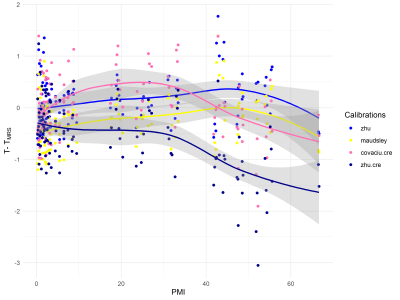 |
74 | Finding the optimal temperature calibration for postmortem MRS thermometry in forensic medicine
Niklaus Zoelch1,2, Jakob Heimer1, Henning Richter3, Michael J. Thali1, and Dominic Gascho1
1Institute of Forensic Medicine, University of Zurich, Zurich, Switzerland, 2Zurich University Hospital of Psychiatry, University of Zurich, Zurich, Switzerland, 3Clinic of Diagnostic Imaging, Vetsuisse Faculty, University of Zurich, Zurich, Switzerland MRI and MRS are finding more and more their way into forensic medicine. Unlike in vivo measurements, however, the temperature of cadavers in forensic medicine varies considerably and affects the performed measurement. The present study investigated how well published calibrations measured in vivo or in phantoms are suited for postmortem MRS thermometry. Postmortem MRS thermometry would allow to estimate and possibly correct the effects of the local temperature in a forensic setting. The study reveals that despite strong postmortem changes, a reliable estimation of the local temperature over up to 60 hours after death is possible with available temperature calibrations. |
||
2173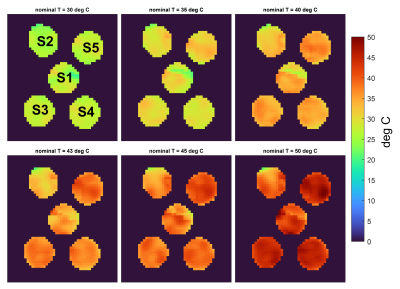 |
75 | Fast T1-based MR Thermometry at Low Magnetic Field
Marco Fiorito1, Maksym Yushchenko1, Davide Cicolari2, Mathieu Sarracanie1, and Najat Salameh1
1Department of Biomedical Engineering, University of Basel, Allschwil, Switzerland, 2Department of Physics, University of Pavia, Pavia, Italy
Thanks to the enhanced T1 dispersion and its linear dependence on temperature over the typical hyperthermia range, T1 mapping represents a serious candidate for temperature mapping at low magnetic fields. Nonetheless, T1 acquisitions are typically long and sensitivity if further reduced at low field regimes. Here we propose a Look-Locker-based temperature mapping sequence that takes advantage of the inherently higher signal gathered using a bSSFP approach. Temperatures spanning from 25 to 50°C could be mapped in doped-water samples with a temporal resolution of 20s/slice and with a precision of 2.6±1.9°C.
|
||
2174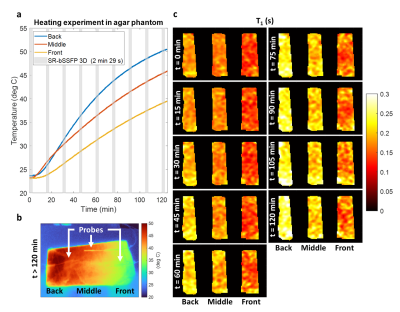 |
76 | Towards MR-guided Hyperthermia at Low Field: a Proof-of-Concept Investigation
Marco Fiorito1, Mauro Spreiter1, Maksym Yushchenko1, Mathieu Sarracanie1, and Najat Salameh1
1Department of Biomedical Engineering, University of Basel, Allschwil, Switzerland MR-guided hyperthermia at low magnetic field is challenging due to the inherently low SNR, which typically calls for multiple signal averages. Dedicated coils are crucial at this field regime, to maximise signal acquisition. In this study we built a custom RF coil which integrates a water-based heating system to reproduce hyperthermia conditions in hands. Using a fast T1-mapping sequence, we could successfully monitor the temperature variations generated in a phantom over 120min. A first in vivo employment in a volunteer’s hand at room temperature was also shown, achieving a spatial and temporal resolution compatible with hyperthermia requirements. |
||
2175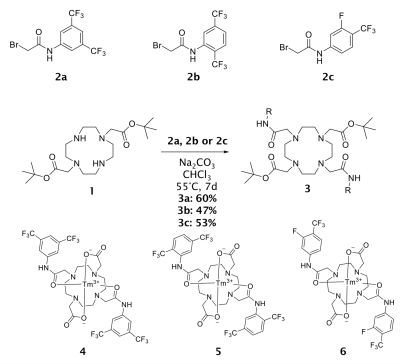 |
77 | Fluorinated Tm3+-complexes as molecular temperature sensors
Felix Mysegaes1,2, Pauline Voigt1, Isabell Prediger2, Johannes Bernarding2, and Markus Plaumann2
1Institut für Organische und Analytische Chemie, University of Bremen, Bremen, Germany, 2Institute of Biometry and Medical Informatics, Otto-von-Guericke University Magdeburg, Medical Faculty, Magdeburg, Germany
Temperature is an important factor for various physiological phenomena. Hyperthermia and hypothermia are only two examples in clinical application. As the resolution of MR data increases, so does interest in the exact determination of the temperature. Molecular sensors offer the opportunity to determine temperature in living organisms. Based on the preliminary investigations of our working group using Ce3+ complexes, the more detailed characterization of Tm3+ complexes was carried out with regard to the temperature sensitivity of the 19F MR signals and, for the first time, also to the toxicity using the example of fibroblasts.
|
||
2176 |
78 | Dual-echo single-shot SMS EPI for improved MR thermometry
Ronald Mooiweer1,2, Raphaël Tomi-Tricot1,2, Axel Joachim Krafft3, Waqas Majeed4, Himanshu Bhat4, Reza Razavi1, Radhouene Neji1,2, and Sébastien Roujol1
1School of Biomedical Engineering and Imaging Sciences, Faculty of Life Sciences and Medicine, King's College London, London, United Kingdom, 2MR Research Collaborations, Siemens Healthcare Limited, Frimley, United Kingdom, 3Siemens Healthcare GmbH, Erlangen, Germany, 4Siemens Medical Solutions USA Inc., Malvern, PA, United States MR thermometry using dual-echo single-shot EPI was evaluated in a phantom. Dual-echo EPI resulted in better temperature stabilities than the single echo acquisitions. This sequence was successfully combined with SMS, which also resulted in higher temperature stability than the single echo acquisitions. |
||
The International Society for Magnetic Resonance in Medicine is accredited by the Accreditation Council for Continuing Medical Education to provide continuing medical education for physicians.